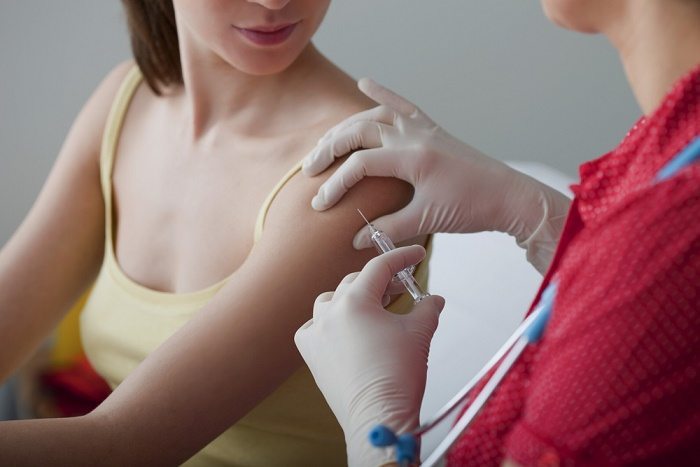HPV Vaccine Rates Up, Still Lag Behind Other Vaccines
The Centers for Disease Control and Prevention released data last week showing that the overall rates of HPV vaccine increased only slightly between 2013 and 2014 but some communities of color made large strides in vaccinating their young people.

The Centers for Disease Control and Prevention released data last week showing that the overall rates of HPV vaccine increased only slightly between 2013 and 2014 but some communities of color made large strides in vaccinating their young people.
The HPV vaccination rate continues to lag behind that of other vaccines recommended for the same age group, which suggests that misunderstandings and political controversy remain over immunizing against a sexually transmitted disease.
Sixty percent of girls ages 13-to-17 received at least one of the three recommended doses of the HPV vaccine in 2014, according to the government data. This marks a 3.3 percent increase from 2013, when 56.7 percent of girls in this age group had received one dose. Far fewer girls—39.7 percent—had received all three doses, though again this is an increase from 36.8 percent in 2013.
Coverage for boys has always been below that of girls, as many people associate the HPV vaccine—which is best known for preventing cervical cancer—with young women. In 2014, 41.7 percent of boys ages 13-to-17 had received at least one dose of the vaccine, which is an 8.1 percent jump from the year before, when 33.6 percent were covered.
Similarly, there was a marked increase in the number of boys who had received all three doses, from 13.4 percent in 2013 to 21.6 percent in 2014.
Hispanic and Black girls and boys were more likely than white girls and boys to have received the vaccine, and coverage was higher among those living below the poverty level compared with those living at or above the poverty level.
Despite increases, the HPV vaccine lags behind other vaccines that are recommended for young people in the same age group. In 2014, 79.3 percent of teens ages 13-to-17 had received the quadrivalent meningococcal conjugate vaccines, and 87.6 percent had received the Tdap vaccine, which covers tetanus, diphtheria, and pertussis.
“The difference between Tdap and HPV vaccine shows we are missing crucial opportunities to vaccinate boys and girls, leaving them at greater risk of HPV infections that can lead to cancer,” the CDC report states. “Though the report does not explain why the HPV vaccine rates are lower, there has been a lot of misinformation and misconception about the vaccine since it was introduced in 2006.”
The HPV vaccine protects against certain strains of the human papilloma virus, a highly contagious sexually transmitted infection. The CDC estimates that 79 million people in the United States are infected with the HPV virus and 14 million new infections occur annually. Though most people won’t suffer long-term health consequences and may never know they have the virus, others may develop cervical cancer or cancers of the head, neck, throat, penis, or anus.
The original version of the HPV vaccine protected against the two strains responsible for most cervical cancer as well as the two that caused most cases of genital warts. A newer version of the vaccine was approved early this year that protects against nine strains of the virus and has the potential to prevent 90 percent of cases of all cervical, vulvar, vaginal, and anal cancer if it is widely used, as Rewire reported.
Parents have been hesitant to get their children vaccinated in part because HPV is a sexually transmitted infection. Some fear that the vaccination will promote promiscuity in young people, but numerous studies have found that not to be the case.
Others question why the vaccine is recommended for those as young as 9, and may put it off until the children are older. The CDC explains that it’s important for people to get all three doses before they are sexually active. Research has shown that some parents do not understand that the HPV vaccine actually protects against cancer.
The CDC is working to increase vaccination rates by partnering with cancer organizations and other stakeholders to educate and motivate parents and clinicians by supporting state and local public health departments across the country that are running vaccination campaigns and by supporting communication efforts targeting both the public and health-care professionals.
The current data on vaccination rates show wide variation between states. For girls, coverage with at least one dose of the HPV vaccine ranged from 38.3 percent in Kansas to 76 percent in Rhode Island. For boys, state-level coverage with at least one dose of HPV vaccine ranged from 23.2 percent in Indiana to 69 percent in Rhode Island.
The CDC notes that those states and communities that put extra effort into promoting the vaccine have success.
For example, Chicago, the District of Columbia, Georgia, and Utah were among the 11 areas that received federal funding in 2013 to improve HPV vaccination coverage, and were all among those that showed better adherence. Chicago’s vaccination rates went up by 20 percent between 2013 and 2014, with more than 78 percent of the city’s girls and almost 65 percent of its boys having received one dose of the vaccine.
The mayor’s office explained that the city had started a public awareness campaign in January 2014 that included print ads on buses and trains, broadcast ads, and digital ads encouraging parents to talk to their child’s doctor about the vaccine.
“The large increases in these diverse parts of the country show us it is possible to do much better at protecting our nation’s youth from cancers caused by HPV infections,” Dr. Anne Schuchat, assistant surgeon general and director of CDC’s National Center for Immunization and Respiratory Diseases, said in a statement. “We are missing crucial opportunities to protect the next generation from cancers caused by HPV.”
